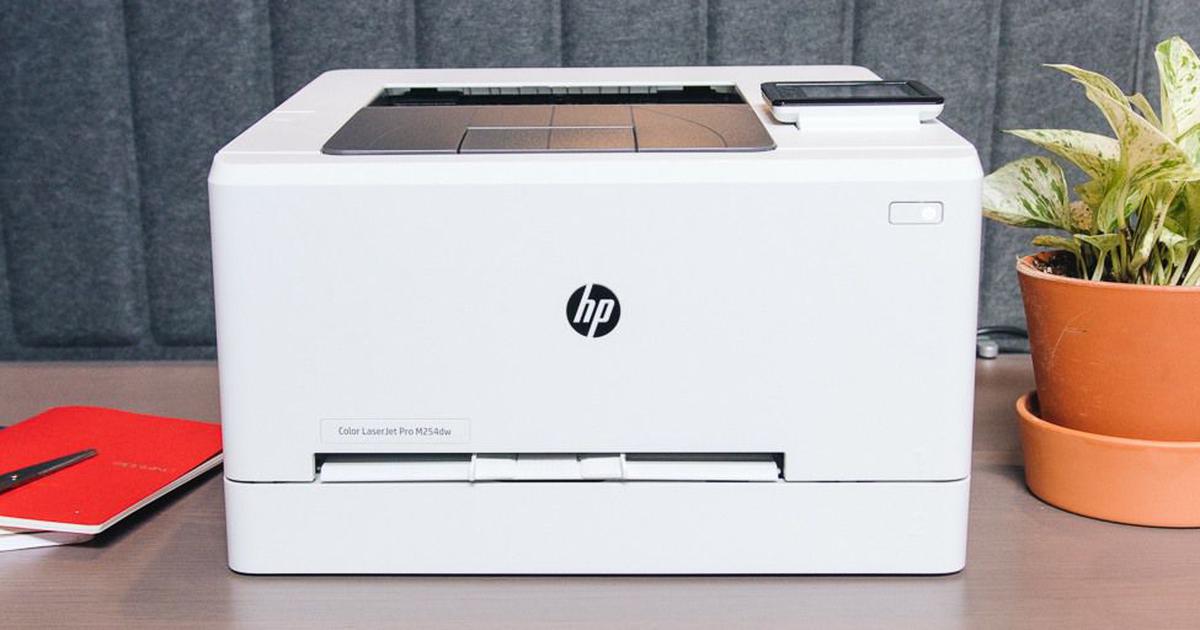
We’ve spent more than 300 hours researching and testing laser printers over the past seven years, and we’ve come away convinced that the best choice for a full-featured laser printer is the HP Colour LaserJet Pro M254dw. Of the 40 current laser printer models we considered, it’s the most reliable and least annoying to use of the bunch, and it can print just about anything most people would want, with beautiful results.
Contents
OUR PICK
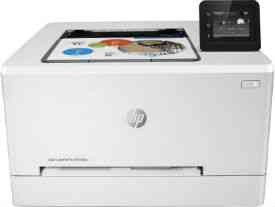
If you need a laser printer that can handle any print job – from tax forms and labels to envelopes and corporate reports – the HP Colour LaserJet Pro M254dw is hard to beat. Its easy-to-use touchscreen interface and HP Smart software really stand out from the competition and make setup and daily use far less frustrating than with other printers we’ve tried. It produces crisp black text and vibrant full-colour graphics with equal ease. The M254dw is also faster than competing models, pumping out around 17 single-sided pages per minute, and it has a convenient bypass slot that makes printing on envelopes and other odd-sized media easy.
BUDGET PICK
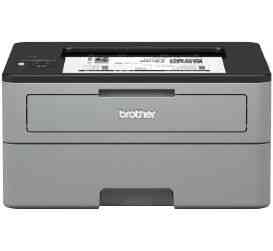
If you’re looking for a relatively cheap laser printer for occasional black-and-white print jobs, we recommend the Brother HL-L2350DW. Setup is painless and the machine is compatible with all major platforms, including Windows, MacOS, ChromeOS, Linux, iOS and Android. Its cost per page is reasonable, it sticks to Wi-Fi like glue and its price is largely affordable. Its print quality is merely adequate right out of the box, but you can improve it with a few simple settings tweaks. Just be aware that the L2350DW can’t scan or copy, so if you need that functionality, look to our monochrome all-in-one pick.
ALSO GREAT
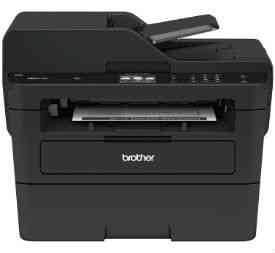
If you like the sound of our budget pick but want the ability to scan and copy documents and photos, the MFC-L2750DW should fit the bill. At its core it’s a very similar printer – and it’s just as easy to set up – but it also has a flatbed scanner and a fast, single-pass duplexing automatic document feeder on top. Its print quality is slightly better out of the box, and you get the same operating costs, the same print speed and the same connectivity options as you do with the L2350DW. For home offices it’s a great do-it-all option – as long as you don’t need colour.
UPGRADE PICK
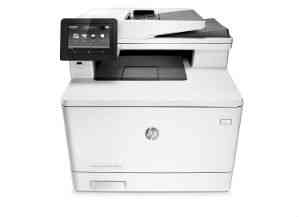
If you have a small business with more serious productivity needs, the HP Colour LaserJet Pro MFP M477fdw is a worthwhile upgrade over our other picks. It’s easy enough to set up and also offers more robust admin settings and security options for a multiuser environment. All-in-one colour lasers like the M477fdw cost more and are more expensive to operate than inkjet printers with comparable features, but they deliver high-quality colour prints, copies and scans at a quicker pace than cheaper models. They’re also sturdier and more reliable than inkjets.
Who should get this
We think laser printers are best for people who need to print a lot, like small-business owners. They’re also great for people who don’t print often but want a machine that will work without complaint on the rare occasions when they do need to print.
To help you decide if a laser printer is right for you, take a look at this brief list of things laser printers tend to do better than inkjets:
- Laser printers are less frustrating to maintain. Laser toner cartridges don’t have to be replaced as often as ink tanks, and they won’t clog – as inkjet print heads sometimes do – if you go weeks or months between print jobs.
- They’re faster. If you have a home office or run a home business, you may be more conscious of printer speed than regular people. Our laser picks can pump out as many as 27 pages per minute while the fastest inkjets we’ve tested maxed out at 13 pages per minute.
- They print sharper text and graphics. The best inkjets do a good job, but even a mediocre laser printer will do a better job delivering crisp results, especially when it comes to fine lines and small font sizes.
- They may be more economical to run in the long term. Some inkjets have a lower cost per page than home laser printers, but they also waste more ink on cleaning. That waste isn’t reflected in the estimates manufacturers provide for how many pages you can get out of a tank. Laser printers don’t waste toner in the same way, and because they don’t gunk up like inkjets, they may last longer before needing to be replaced.
- Toner doesn’t smear and run when it gets wet. If you need prints that can get wet without becoming unreadable, you want a laser printer.
But laser printers aren’t for everyone, because they’re not great at everything. Here are a few reasons why you might want to stick to an inkjet:
- Inkjets cost less to start with. You’d be hard-pressed to find a laser at the price of a basic inkjet.
- Their ink tanks are cheaper to replace. Toner cartridges may last longer, but replacing an entire set of them is an expensive proposition. Replacing smaller, less expensive ink tanks more often can be easier on your budget, even if it doesn’t really save you money in the long run.
- They can print glossy photos. Sure, laser printers can print a photo on plain paper, but they can’t deliver prints on glossy or matte photo paper. If you want to make frame-worthy prints, an inkjet is your only choice.
- They can print on other stuff besides paper. CDs, metal and other unusual media are fair game, which makes them much more versatile for crafty types.
If you think you want an inkjet instead of a laser, we recommend the best inkjet machines here.
How we picked
Laser printers have a few clear subcategories, and for this guide we looked for good options in each of them.
Colour print-only
In the past, we considered colour laser printers an extravagance for home use, due to the high cost of colour toner and the higher up-front cost of the machines themselves. However, prices have gradually dropped into a more acceptable range, and we think that these printers now provide the best all-around value for people who want a trouble-free printing experience. They’re still expensive compared with inkjets and monochrome lasers, but the convenience factor and flexibility of a colour laser machine can’t be overstated.
To find the best colour laser printers, we scouted all of the current colour laser printers we could find, based on our cutoff for affordability. Then we refined the results by considering only those with automatic duplex printing, Wi-Fi and support for today’s mobile printing standards. We favoured models with cheaper toner costs. To weed out any clunkers that had good specs but poor real-world performance, we read through hundreds of customer and professional reviews. This netted us two serious contenders: the Canon ImageClass LBP612Cdw and the HP Colour LaserJet Pro M254dw.
Monochrome print-only
Because they’re fundamentally similar machines, we applied most of the same criteria we used to find our colour laser pick, but reduced the price ceiling because mono laser printers tend to be much less expensive. With those parameters, we ended up with just two contenders. Unfortunately, we found out that one of them is unlikely to be available for much longer, so we decided to test the other – the Brother HL-L2350DW – to confirm that it’s the best choice for people with just occasional printing needs.
Monochrome multifunction
Although a print-only machine is sufficient for most people, plenty of other people – particularly small- and home-business owners – also want a copier and scanner. So we sought out monochrome multifunction printers with a reasonable purchase price, low toner costs, Wi-Fi connectivity, mobile apps, duplex printing and an automatic document feeder (rather than just a flatbed scanner).
Our research turned up 14 mono MFPs that fit those criteria. We read owner and professional reviews to seek out the best of these, and ultimately selected two test models: the Brother MFC-L2750DW and Canon ImageClass MF249dw.
Colour multifunction
Finally, we looked for a high-end colour laser all-in-one for people with more serious small-office or home-office needs. It needed to be fast and flexible, offer great print and scan quality and have a relatively affordable price (though none of these machines are cheap).
Filtering through the colour laser AIOs from top manufacturers, we arrived at four models that checked off all our requirements: the Brother MFC-9340CDW, the Canon Colour ImageClass MF733Cdw and the HP Colour LaserJet Pro M477fdw, the upgrade pick in our all-in-one printer guide.
How we tested
Your first experience with a printer sets the tone for the relationship to come. If setup is a breeze, you’ll have a much more positive attitude toward the machine going forward. That’s why we paid especially close attention to the installation process, from the physical unboxing to wirelessly connecting each machine to a Windows PC, Mac, iPhone and Android device. We considered setup a success when we were able to print a two-sided document from each platform over Wi-Fi, turn the machine off and back on, and do it again.
Because simply getting a job to print can be frustrating, we also tested other ways to wirelessly interact with these machines. As it’s vital for Chromebook owners, we made sure each printer worked with Google Cloud Print. We considered it a success when we could print using Google Cloud Print from a phone using cellular data. Where available, we also checked out other mobile printing standards and proprietary systems, like Mopria and HP ePrint.
You’d have to try hard to find a laser printer that doesn’t offer at least respectable print quality, but some still manage to stand out from the pack. To separate the great from the merely good, we printed several text-based reference documents that also included elements like columns, tables, or charts: instructions for the 1099 tax form (PDF), a star chart designed for lens sharpness testing, a document from the International Organisation for Standardisation (ISO) meant to mimic a typical office report, and a simple Word/PDF document with the same sentence repeated in descending font size from 72 points to one point. We printed a few high-resolution photos, too, because more data is always better, and seeing how each printer handles material that really pushes against the limits of its capabilities can be instructive.
We also checked out each printer’s quality options, including toner-density sliders and any available print-resolution settings to see what you can expect with toner-saving options and to find out if we could eke out better-looking text.
Experimenting with quality settings also helped us get familiar with the print menus. We spent time in the standard print box, as well as the more arcane, Web-based control panels that most printers employ for more technical adjustments.
To test printing speed, we ran off four copies of the four-page ISO document in both duplex (two-sided) and simplex (one-sided) modes. We timed the whole process, from hitting Print to the last sheet coming out of the feeder, so that it included any warm-up time required from a cold start. We also tried duplex printing at the highest quality setting for each printer. These tests give us a feel for not only how fast a printer will be able to spit out a 10-page book report, but if the differences between them are substantial enough to make a difference in day-to-day life.
For the multifunction printers, we added speed tests for copying and scanning a large (50-page) document composed of mixed output from our printing tests, again considering both duplex and simplex speed. We also tested the flatbed scan quality of each multifunction printer using a glossy test photo printed on our inkjet all-in-one pick, the HP OfficeJet Pro 8720. We scanned at all available resolutions and looked for notable qualitative differences between each machine’s output, from sharpness to colour rendition and contrast.
Finally, we stress-tested all of the paper-feeding parts of each printer, including not just the main paper tray, but also the bypass tray and document feeder, if the printer had them. We (slightly) overstuffed them with paper to see if they’d jam, and we also fed them single sheets to see if they could pick each up. We also fed the multifunction printers a crumpled piece of paper to see if their ADFs could handle the unexpected.
Our pick: HP Colour LaserJet Pro M254dw
OUR PICK
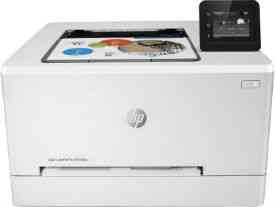
The HP Colour LaserJet Pro M254dw is fast, powerful, flexible and – most important – easy to use, which in our book makes it the best laser printer for most people. We love the responsive control panel, the modern design of HP’s PC and mobile software and how easy the printer is to set up and get on Wi-Fi. Toner is affordable, and you can get it in extra-large cartridges that are good for more than 3,000 pages, which should last most people a very long time before needing replacement. Print quality is excellent across the board, and all of the features you’d expect from a high-end machine are here: auto-duplexing, plenty of networking options, support for common mobile printing standards and a bypass slot for odd-sized media.
Setting up the M254dw is painless, thanks in large part to the surprisingly helpful Getting Started guide. It lays out three different ways to set up a printer-PC connection: USB, Ethernet and Wi-Fi. Despite the included USB cable (a rarity these days), we think most people will use Wi-Fi, so that’s the path we chose. With the touchscreen, establishing a wireless connection was as easy as picking our router out of a list and typing in the password. Unlike most other printers we tested, the HP also provides a full QWERTY keyboard, which made entering a complex passkey a lot less frustrating.
Wi-Fi and that touchscreen interface are a couple of areas where the M254dw excels. Maintaining a solid wireless connection has traditionally been a struggle for printers, but this HP performed without fail during our testing, boosted by a first-in-class feature: dual-band Wi-Fi. Yep, the M254dw works on either the standard 2.4 GHz band or the typically less populated and faster 5 GHz band.
The bright and high-resolution colour touchscreen display makes navigating the printer’s many settings menus easy. All of the other printers we tested for this guide use old-school resistive touchscreens that aren’t nearly as accurate or easy to use as the capacitive touchscreens on most smartphones. This screen isn’t as big as the ones on larger all-in-one printers, like our upgrade pick, but it’s still a significant upgrade over the one-line mono readout of our budget pick or the blocky, low-res monochrome touchscreen on the Canon ImageClass LBP612Cdw we also tested.
Once the M254dw is connected to your network, you can grab the appropriate drivers and software for your Mac or Windows PC by heading to 123.hp.com and clicking the link for “LaserJets or PageWides” at the bottom of the page. (Alternatively, you can just click here.) That’ll get you the HP Easy Start installer, which walks you through getting the printer connected, registered, and working with your computer. This process took longer with this printer than with other HPs we’ve tested, but we were still able to wrap everything up within a half an hour. Connecting a smartphone or tablet is much quicker. You can download the HP Smart app (Android and iOS) and add the printer with just a couple taps.
Operating costs for the M254dw are low, but bear in mind that these are only estimates – if you’re printing full-page colour photos, you can expect to get fewer pages out of each toner cartridge, while a mostly text-based page with a few colour graphics could stretch the toner further and lower your cost per page. HP’s toner cartridges feature an integrated drum, so you don’t have to worry about buying a new one after a couple years. If you want to make your money stretch a little further, you can make the printer default to duplex printing and adjust menu settings to reduce toner usage. We don’t recommend handing out reduced-toner prints to clients, but the results are passable for everyday personal use.
The M254dw model’s 250-page main paper tray (which can accept everything up to legal size) is larger than many in its class, so you’ll have to fill it less often. A dedicated bypass slot for odd-sized media means you also won’t have to take your regular paper out if you want to print on envelopes, labels or card stock. The slot is motorised, which was a little off-putting the first time we used it. When you slide an envelope or label sheet into the slot, rollers grab it and suck it into the guts of the printer, where it sits until you send a print job. (However, we weren’t able to find a way to get the printer to eject paper from this slot without printing, which seems a little strange.)
We couldn’t get the M254dw to jam, no matter how hard we tried. When we crammed the paper tray with as many as 50 extra sheets, a warning popped up on the control panel saying the tray was overstuffed, and the machine refused to print. (In this situation, other printers would try, fail and jam.) When we put exactly 250 pages in, it printed normally, and it was the same with just a single sheet in the tray. If we had run into a jam, however, there printer’s back has a convenient access hatch to remove it.
At default settings, the M254dw produces crisp, dark black text that’s readable down to two points. Results are similarly impressive when printing business-style graphics and household miscellany like comics, colouring book pages and crosswords. We didn’t observe any jagged lines or banding in solid-colour areas – two problems that often plague cheaper models. Although it can’t print on photo paper, we ran a few high-resolution test photos through the HP on plain paper and came away generally pleased with the results. The prints are a touch washed out, but you get accurate colours, lots of detail, and relatively low noise. These aren’t photos you’d want to hang on a wall, or even display on your fridge, but they’re more than adequate for the cover of a business presentation or a school paper.
HP claims the M254dw can print as fast as 22 pages per minute in black and white, but in our testing it maxed out around 17 pages per minute while printing a PDF consisting of mixed text and graphics. That’s an impressive result – slightly quicker than the Canon LBP612Cdw we tested it against, and certainly fast enough for most home and home-office purposes. Colour printing was just a touch slower at 15 pages per minute, and duplexing in either monochrome or colour dropped the speed further, to 11 pages per minute. Again, quicker than the competition.
Flaws but not dealbreakers
Early owner reviews noted various problems, most commonly colour accuracy and Wi-Fi stability, though it seems that subsequent firmware updates have fixed many of these issues. During testing, we had trouble getting the printer registered with Google Cloud Print before we updated the firmware, but afterward, it worked right away. Our advice: always attempt a firmware update immediately after setting up any printer. You’re less likely to run into issues that way.
Another common owner complaint is that the M254dw can be slow to start printing. We observed this only once during testing, when printing our high-resolution colour test photo. In that case, the machine took a little over a minute from receiving the job to start printing. Every other job we ran started right away, from Word docs and PDFs to smaller JPEGs and PSDs from Photoshop.
The M254dw comes with a skimpy set of “starter” toner cartridges good for 800 black-and-white and 700 colour pages. High-capacity replacements are good for up to 3,200 monochrome and 2,500 colour pages, but a full set is expensive. This isn’t a problem limited to the M254dw – almost all consumer laser printers (including alternatives we considered and tested) come with these corner-cutting cartridges, but it’s annoying nonetheless. Most buyers should be prepared to dish out for replacement toner within the first year or so, but the replacement point could come a lot sooner for people using the printer in a home office. Third-party toner can be had for around half the price of the genuine HP product or so but we can’t guarantee it’ll work for you, so will have to explore that option at your own risk.
Colour laser printers are bigger and heavier than their monochrome counterparts, because they use four toner cartridges rather than just one. The Colour LaserJet Pro M254dw is no exception: it’s more than twice as heavy as our budget pick (the Brother HL-L2350DW), but still far smaller and lighter than a colour all-in-one like our upgrade pick (the HP Colour LaserJet Pro MFP M477fdw). It’ll take up significant space on your desk, but it won’t colonise it the way an all-in-one would. It also probably won’t fit on your bookshelf, thanks to its 19-inch depth.
Budget pick: Brother HL-L2350DW
BUDGET PICK

The Brother HL-L2350DW is a simple, largely affordable and dependable monochrome laser printer. For people with basic needs – printing taxes, recipes, boarding passes and so on – its automatic duplex capability, large 250-sheet paper tray, reliable paper handling, speedy printing and low per-page costs make it an excellent choice, despite a few quirks.
With a machine this straightforward, physical setup is quick. You only have to remove the packing tape, insert the toner cartridge, adjust the paper-tray guides and load some paper. Getting the printer on Wi-Fi is a little more complicated to do with this model than with some other printers, because the HL-L2350DW employs a decidedly old-school user interface that consists of a one-line monochrome LED display and an array of rubber buttons. There’s no way to type in a Wi-Fi passkey on the machine itself, so you have to complete the process with the help of a PC. Even so, we were able to get connected to our network within a few minutes, and the printer reliably maintained a connection throughout testing – even several rooms away and a floor below our router. Some owners reported issues with this printer’s predecessor, the L2340DW, refusing to wake up from Deep Sleep mode, so we were happy to find that the new model didn’t give us any issues during our testing. You can operate the L2350DW over USB, if you prefer, but you’ll have to supply your own cable. If you want an Ethernet port for wired Internet, you can upgrade to the otherwise nearly identical HL-L2370DW.
The L2350DW works with Windows PCs, Macs and even Linux systems. It’s also compatible with all major mobile printing standards, including Google Cloud Print, which means it’s a solid pick for Chromebook owners. However, you may have issues getting the printer to complete Cloud Print registration – we certainly did. For us, the solution was to access the printer’s Web control panel, navigate to the Networking tab and disable IPv6. With that done, the printer was able to get on Cloud Print right away and worked flawlessly for the remainder of testing. It’s a mystery why Brother ships the L2350DW with this setting enabled, considering that it’s a known fact that Cloud Print doesn’t work with IPv6. At least it’s an easy fix.
You don’t really need to install any extra software for the L2350DW, because it has native Windows and Mac drivers. It also works automatically with AirPrint on iOS, and can be added with the Brother Print Service on Android. Brother’s iPrint&Scan app is available for all four platforms. It’s perfectly functional, if not as well-designed as HP’s software. Unfortunately, in our testing, printing from iPrint&Scan resulted in horrendous quality, regardless of the quality setting selected. We reached out to Brother for comment, but the company wasn’t able to provide any explanation for the print-quality discrepancy. In general, we’d recommend you avoid the app and print through your operating system’s native print dialog, which works just great.
Right out of the box, the HL-L2350DW produces good-looking text. Tax forms and other documents with tiny fonts (all the way down to two points) are perfectly readable, and larger headers come out with crisp edges and dark centres. All in all, this printer should be more than adequate for printing text-heavy documents. Graphics and photos, on the other hand, are merely mediocre at default settings. Some light banding is visible in solid-colour areas, and graphics appear a little grainy. The output is good enough for personal use or internal business documents, and you can improve it with adjustments to toner density and resolution settings (at the expense of toner longevity) if you need to hand out documents to clients.
Brother claims the L2350DW can print at up to 32 pages per minute, which is five pages per minute faster than the machine it replaces. It wasn’t quite that fast for us, but it was still speedy enough for just about any home or home-office use we can imagine. We clocked it at 25 pages per minute while printing single-sided PDFs, and 12 pages per minute while using duplex – faster than our top pick, the M254dw, in both cases. Print jobs reliably started up within a couple seconds, too, so you won’t be left waiting long in any case.
One of the best things about the HL-L2350DW is its low cost of ownership. Operating costs are low, too. Even accounting for drum wear, each print is right in line with the other models we recommend. And optional 3,000-page high-yield cartridges mean you won’t need to replace your toner too often. (However, like most other laser printers, the L2350DW comes with a puny starter cartridge good for just 700 pages.)
This printer is extremely small and light. At just 15.9 pounds, it’s more than 10 pounds lighter than our next smallest pick, and its footprint is significantly smaller as well. It’s especially short at 7.2 inches tall, which should help you fit it on a bookshelf. But it’ll just as easily find a space on your desk, or anywhere else you might want to shove it.
However, don’t expect great build quality from a relatively cheap printer like the HL-L2350DW. Our test unit came in a very banged-up box (thanks, FedEx) that released a confetti of shattered styrofoam when we opened it. After getting the printer up and running, we immediately noticed that duplex printing wasn’t working – every time we printed a two-sided document, it jammed in exactly the same place. We hopped on the phone and a Brother customer support agent quickly diagnosed the problem: a plastic guide in the paper path that had gotten knocked out of place in transit. It was simple enough to pop it back in where it was supposed to go, but it speaks to the L2350DW’s flimsiness (and shoddy packaging) that the issue happened in the first place.
Also great: Brother MFC-L2750DW
ALSO GREAT
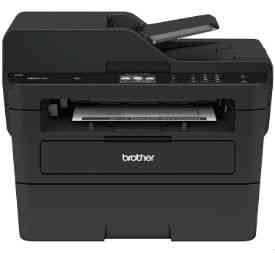
If you work from home, run a home business, or simply want the flexibility of a laser printer that can also scan and copy, we recommend the Brother MFC-L2750DW. This powerful machine marries the basic utility and reliability of our Brother HL-L2350DW budget pick with the versatility of a flatbed scanner and single-pass duplexing automatic document feeder. It’s dependable, quick, cost-effective and reasonably compact, and can handle everything except colour print jobs. (Yes, including faxing.)
The MFC-L2750DW is even simpler to set up than its little sibling, because you can connect it to Wi-Fi using the colour touchscreen control panel. The interface is easy to navigate, if not quite as user-friendly as the one on our main pick. It includes a number of handy built-in apps, including Dropbox and Google Drive, so you can walk up and print directly from your cloud accounts. It also has a scan-to-email app, which is refreshingly simple to configure. It timed out on us a few times when trying to scan very large jobs, but otherwise worked quickly.
Default print quality from the L2750DW is good enough for home and internal business use – a small step ahead of our budget pick Brother HL-L2350DW, with sharper text at small font sizes and marginally better graphics performance. But for professional-looking brochures or presentations, you’d probably want to use a printer like our upgrade pick HP Colour LaserJet Pro MFP M477fdw, or punt the job to a pro print shop.
Scans from the automatic document feeder look just fine, though they can come out a bit crooked if you don’t micromanage the paper guides on the ADF tray (a fault shared by many all-in-ones). Flatbed scans sidestep this issue and have excellent sharpness thanks to the 1200 dpi maximum resolution (double what some competing machines offer). You can scan to email, a network computer or drive, an FTP server or cloud apps like Dropbox and Google Drive. Unfortunately, this printer lacks a USB port, so you can’t save your scans directly to a thumb drive.
Thanks to its single-pass duplexing automatic document feeder, scanning is really quick even with two-sided documents – 24 pages per minute in black and white and eight pages per minute in colour. The Canon ImageClass MF249dw we tested was just as fast with single-sided documents, but 66% slower at duplexing because it took two passes to scan a two-sided sheet.
The L2750DW shares a couple of annoying but easily fixable faults with its print-only stablemate. As with the L2350DW, print quality degrades when you initiate jobs from Brother’s iPrint&Scan app, so you should use your operating system’s native print dialog instead. Google Cloud Print doesn’t work from the get-go – or didn’t for us, anyway – but you can fix that by disabling IPv6 in the Web control panel’s networking options.
This machine feels pretty flimsy, but the upside is that it’s light and compact for its class, which makes it easier to fit into your space. When you first set it up, just be sure to check for any plastic pieces that might have jumped out of place, and run a few print and scan jobs to make sure everything is working properly. If it’s not, give Brother’s customer support a call before returning the machine as the fix might be really simple.
Upgrade pick: HP Colour LaserJet Pro MFP M477fdw
UPGRADE PICK

If you need (or just want) a more serious printer than our other picks, the HP Colour LaserJet Pro MFP M477fdw is an all-in-one that can print in colour and comes with all of the most important productivity features, including duplex printing and scanning, wireless connectivity and fax capability. This is a solid fit for small businesses – more powerful than your typical inkjet all-in-one, yet smaller and more affordable than the hulking enterprise machines you’d see at your local cubicle farm.
Though not enterprise-grade, the M477fdw is still huge and heavy at more than 51 pounds. Just removing it from the box can be a struggle, so make sure you have help on hand before you start setting it up. Once it’s unboxed, getting it running is straightforward: remove the packing tape, adjust the paper guides, insert some paper and power it up. Connecting to Wi-Fi is simple thanks to the touchscreen interface, which is a huge, colourful, capacitive panel that behaves just like a smartphone screen. As with other HP laser printers, you can head to 123.hp.com, click the “LaserJets or PageWides” link, and acquire all the software your PC or Mac needs to establish a satisfying working relationship with the machine. As we’ve noted elsewhere, we really like the HP Smart software because it’s super user-friendly in both computer and smartphone form.
Like other recent HP printers, the M477fdw is compatible with all major mobile printing standards, including Google Cloud Print and Mopria. HP also offers its own print service, HP ePrint. Essentially, your printer gets its own email address, and you can email it JPEGs, PDFs, and other files (up to 10 MB per email) to be printed. It works great. Scanning is similarly simple. You can use the HP Smart app to scan directly to your phone or PC, or send scans directly to Google Drive, Dropbox, and other cloud storage services via apps on the printer itself. As you’d expect from a business-oriented machine, you can also scan to email or a network drive, and the printer has a USB port so you can scan to a thumb drive. You can also use the same port to print Word files, PDFs, and photos.
We found that the M477fdw produces very sharp text, similar to that of the M254dw, our main pick, and outdoing both of our monochrome laser picks at smaller font sizes. Graphics look clean and crisp, with accurate colours and smooth edges, and there was none of the banding and excessive darkness or lightness that we’ve seen from budget laser machines. The results are suitable for everything from personal use to business presentations. You’ll never have to worry about the quality.
Like most laser printers, the M477fdw is very fast. We clocked its print speeds at around 27 pages per minute, even over Wi-Fi. Scanning is nearly as quick. We timed it at 25 single-sided black-and-white pages per minute, or 11 double-sided colour pages per minute. The M477fdw can scan both sides of a two-sided document in a single pass, which contributes to its blazing speed. And as befits a professionally oriented machine, this printer is up and printing just a couple of seconds after you begin the print job – even if you’ve let it sit for weeks between uses.
The M477fdw’s toner costs are about the same as those of the Brother MFC-9340CDW, and cheaper than those of the Canon Colour ImageClass MF726Cdw and HP’s own Colour LaserJet Pro M277dw.
As we noted with the Brother MFC-L2750DW, the M477fdw can sometimes produce slightly crooked scans from the document feeder, so to keep your results as uniform as possible, be sure to check that the guides are tight against the sides of your document before you start. Some of our commenters have also pointed out that the M477fdw model’s ADF maxes out at a resolution of just 300 dpi, which is quite pedestrian, so if you need higher-quality scans, you’re going to have to use the flatbed scanner, which can go up to 1200 dpi.
HP makes plenty of similar LaserJet models (including variants in the 477 series), so if you don’t think you need all the features that this specific model offers, look around – you can expect similar performance elsewhere in the line.
The competition
Colour print-only printers
We also tested the Canon ImageClass LBP612Cdw but came away disappointed with its interface and Wi-Fi performance. It’s a good machine, but the HP we picked is better.
The HP Colour LaserJet Pro M452dw is the big sibling to our main pick, the M254dw, with slightly faster printing, more paper-handling options and a slightly lower cost per page. But it costs a lot more up front, as well. If you can find one on sale, go for it, but we think the M254dw usually strikes a better balance between price and performance for most people.
The Xerox Phaser 6510/DNI is a powerful colour laser machine, and both owner and editorial reviews report very good print quality. However, they also mention networking issues with some routers, along with parts failures.
Monochrome print-only printers
The Canon ImageClass LBP6230dw is cheap and small, and has automatic duplexing and Wi-Fi connectivity. But the cost per page is too high, and it doesn’t support AirPrint or Google Cloud Print, which is a problem if you own a Chromebook or want to print from a mobile device.
The Dell E310dw is nearly identical to our previous budget pick, the Brother HL-L2340DW, but Dell hasn’t updated it in years. It’s probably a fine printer, but newer, better models are available.
Monochrome multifunction and all-in-one models
The Brother DCP-L2550DW is a good option if you don’t need some of the features that our monochrome multifunction pick offers. Specifically, this one lacks duplex copy and scan, fax capability, and a touchscreen interface.
The Dell E515dw is pretty inexpensive and has solid owner reviews, but also has a high cost per page and isn’t rated to print as many pages per month as the models we tested.
Colour all-in-one models
The HP Colour LaserJet Pro M281fdw is essentially a scaled-down version of our pick: slower, smaller and less robust. If your needs aren’t too demanding, you might want to consider it, but we think the M477fdw is a more complete solution for most home and small businesses.
[“source=scroll”]

